Motorcycle HID Headlight Conversion
This wasn’t my first attempt to add aftermarket HID lighting to my 2004 BMW K1200LT.
Last spring I fell for a “too good to pass up” $129.99 eBay conversion kit sold by CQ Lighting (similar kits can be had for under $80 now).
Ten days after making my payment, I received a tattered box from Hong Kong.
As I muddled my way through the instructions, I was disappointed to find that rather than the nice, snug fit of the stock bulb, the HID “bulb” slipped right through the socket in the headlight.
Two days later I emailed the seller, informing them that they had sent the wrong size bulb.
Their response informed me that I was to ship the entire contents back to Hong Kong after which the company “…would determine whether the equipment was damaged, and how much we would be to charge you for exchange [sic]…”.
It took three more emails to convince them to ship me a correct bulb and a postage-paid return envelope.
After finally getting it installed, I was thrilled with the dramatic improvement in visibility…for three days. Then the igniter stopped functioning.
My email to the company (which claimed to have over three thousand customers at the time) initially resulted in an identical demand for me to return the equipment to Hong Kong at my expense for them to evaluate whether they would correct the issue.
When I threatened to rescind my PayPal payment instead, a miraculous upgraded igniter became available and was shipped the next day. That one worked for a whole week… So I removed the HID hardware, re-installed the OEM lighting, and demanded a refund.
Apparently the language in my correspondence was strong enough to get the attention of the seller, as a brand new kit arrived via FedEx the next day. Against better judgment, I once again opened the toolbox and went to work, installing the “new and improved” lighting kit that looked to my untrained eye to be exactly the same as the one that added ten years to my life in unbridled frustration.
I quickly experienced the same problems, the most dangerous of which was that the system wouldn’t work every third time I started the motorcycle — something I wouldn’t know in the daytime if I didn’t walk around the front of the bike or pull behind a clean, dark-colored vehicle. So again, I pulled the HID hardware and re-installed the OEM lighting, figuring “you get what you pay for.”
Pete generously donated his honorarium for writing this article to charity (see wBW Charities).
XenonDepot HID Conversion Kit
The HID motorcycle conversion systems from XenonDepot are advertised as “not just automotive kits split into two.”
Special features of the system include plug-and-play wiring harnesses (for H1, H3, H7, H11, 9004, 9005, 9006 or 9007 bulb systems), special vibration-resistant ballasts made for motorcycles, six feet of wiring between bulb and ballast instead of the usual eighteen inches to allow for various mounting options, and a weather-proof and heavy-duty igniter system.
Offered in 4300K, 6500K and 8000K temperatures (the measurement for color in this kind of lighting), I opted for the 4300K system which XenonDepot advertises as “…utilizes cutting edge HID components made with superior Japanese craftsmanship and quality,” and includes, “German engineered Philips capsules (which) have been laser calibrated to ensure proper fitment and optically correct beam patterns.”
Shipping took about three days; my HID conversion kid was shipped via UPS and carefully packed. Here are a couple of photos of the XenonDepot kit on the left vs. the CQ Lighting kit on the right:
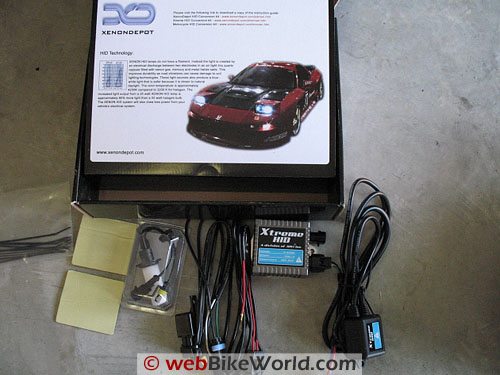
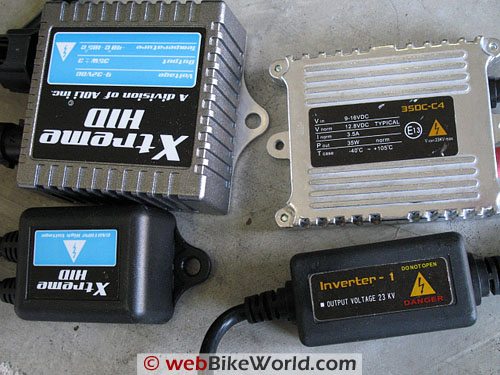
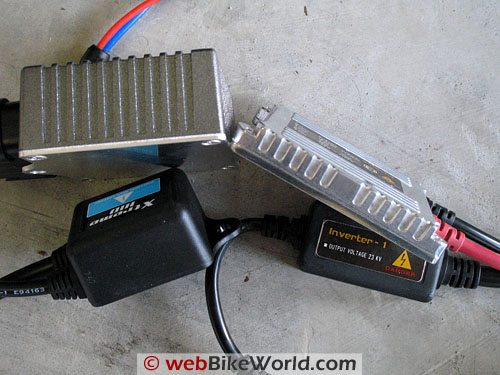
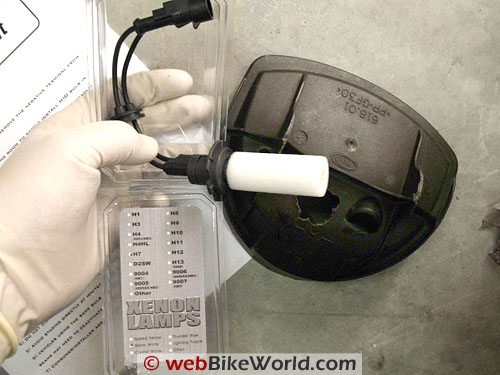
Where to Buy Motorcycle HID Headlight Conversion
Check Reviews & Prices on AmazonAlso Shop for: LED Lights and Bulbs, Auxiliary Driving Lights, Motorcycle LED Headlights
Installing the XenonDepot HID Light Conversion Kit
HID lighting installations will, of course, vary, depending upon the make and model of motorcycle and other factors. Kits may not be available for all motorcycles, but HID kit prices have dropped dramatically over the last few years and the kits now usually include everything the owner might need to make the job easier.
Here’s a pictorial overview of an HID light installation on a BMW K1200LT. These steps are fairly generic and will probably be applicable to many other motorcycle models:
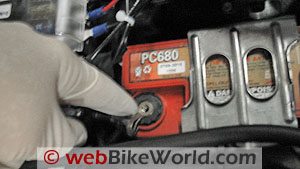 Disconnect the negative terminal from the battery.
Disconnect the negative terminal from the battery.
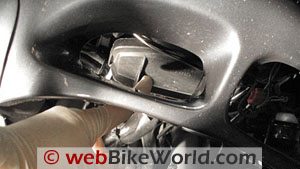 Remove headlamp cover; that is, the cover that protects the back side of the bulb.
Remove headlamp cover; that is, the cover that protects the back side of the bulb.
On the K1200LT, it’s under the nose, a metal “spring” bar holds it in place, just pull the spring down to disengage and free the plastic cover.
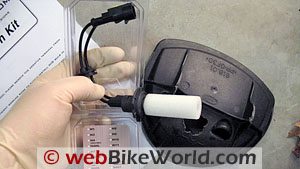 CAREFULLY remove bulb from separate packaging, leave the foam protection on the bulb.
CAREFULLY remove bulb from separate packaging, leave the foam protection on the bulb.
Be extra careful not to get any finger oils on the HID bulb as it can cause premature bulb failure! If you do, wipe it with a tissue soaked with rubbing alcohol.
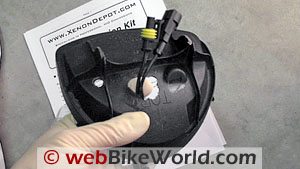 Drill a 23mm hold in the headlamp cover — mine is sloppy from a previous install, do a better job than I did!
Drill a 23mm hold in the headlamp cover — mine is sloppy from a previous install, do a better job than I did!
Feed the wires through the cover so the plugs are on the outside.
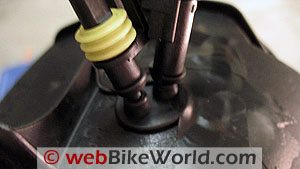 Slide the rubber grommet that is attached to the wires through the 23mm hole, forming a seal.
Slide the rubber grommet that is attached to the wires through the 23mm hole, forming a seal.
The top photo shows the XenonDepot wires; compare those to the wires on the CQ Lighting HID bulb in the bottom photo!
Note that I used electrical tape to seal
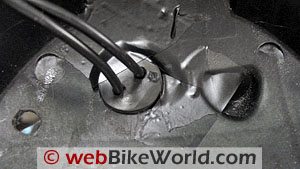
the drill hole area that would be filled by the system’s rubber gaskets had I not made too large an opening in previous install attempts.
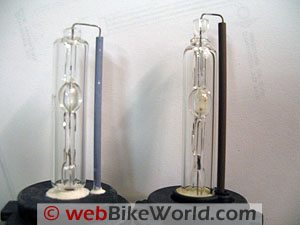 HID bulb differences: The CQ Lighting HID bulb is on the left, and the XenonDepot bulb is on the right.
HID bulb differences: The CQ Lighting HID bulb is on the left, and the XenonDepot bulb is on the right.
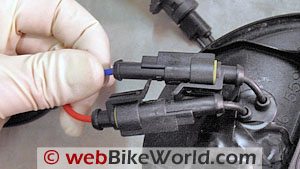 Layout the rest of the HID kit.
Layout the rest of the HID kit.
Then connect the wires to the bulb. Note that there is only one set of wires that connect to the bulb, and only one way to connect, so it’s foolproof.
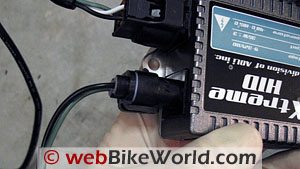 Connect the HID light ballast wiring and igniter wiring.
Connect the HID light ballast wiring and igniter wiring.
Aagain, only one thing fits in here, so it should be foolproof.
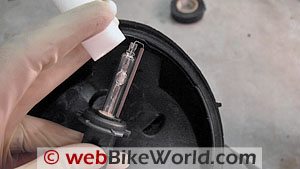 CAREFULLY remove HID “bulb” cover and place it in the empty socket where the OEM bulb was.
CAREFULLY remove HID “bulb” cover and place it in the empty socket where the OEM bulb was.
Note: the HID “bulb” has tabs that fit in notches in the socket — if it doesn’t fit securely, the buld is not aligned properly.
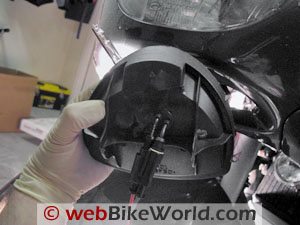 Secure the HID “bulbs” in the socket.
Secure the HID “bulbs” in the socket.
On the K1200LT, there are two steel springs that bend over and secure in plastic tabs, your motorcycle is probably similar — see the shop manual if it’s not obvious. Then secure the headlamp cover back in place.
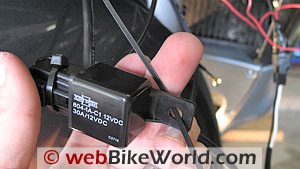 Run a zip-tie to secure the relay. Longer zip-ties may be necessary; two can be connected to work.
Run a zip-tie to secure the relay. Longer zip-ties may be necessary; two can be connected to work.
Remember, it’s weather-resistant, so as long as it’s out of sight, no big deal.
Where to Buy Motorcycle HID Headlight Conversion
Check Reviews & Prices on AmazonAlso Shop for: LED Lights and Bulbs, Auxiliary Driving Lights, Motorcycle LED Headlights
Plug and Play
Connect the headlight “negative” and “ground” to the HID wiring harness. This is easy to do — everything is plug and play and all of the wiring is shown on the downloadable instructions from XenonDepot.
Two wire leads are left; one goes to ground and the other (with an in-line fuse) goes to a battery “Positive”. This is illustrated in the directions.
As an added measure of safety, I connected my “positive” battery connection to an aftermarket fuse block. This isn’t necessary, but since it IS a BMW K1200LT, I naturally have 300 other accessories attached, so it makes add-ons easier.
Final step: re-connect your battery lead, and enjoy…
NOTE: Typically, HID conversions are not used for high-beam lamps because “flash-to-pass” usage can result in premature bulb failure.
HID bulbs don’t have a filament in the middle like conventional bulbs, rather an inert gas is electrified which in turn gives off light in different color “temperatures.” It takes a few moments for the “bulb” to reach full heat (and full intensity of light) when the system has been turned on. Rapid on/off doesn’t allow the lamp to throw light properly, and can damage the mechanism.
Here are some before/after photos:
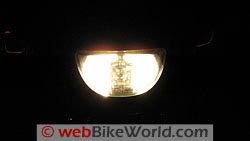
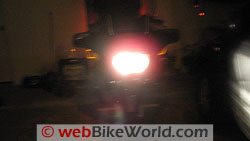
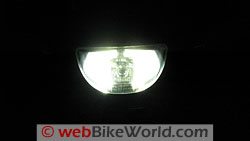
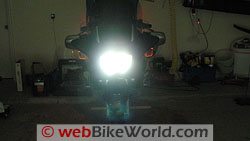
HID Lights: Low or High Beam?
webBikeWorld reader “N.W.” wrote and asked a great question: “Thanks for yet another interesting and informative article, even though it may end up costing me money (like so many of the articles!) when I install HID lights on the Guzzi, but what the heck. However, I do have one question: the article says “Typically, HID conversions are not used for high-beam lamps because “flash-to-pass” usage can result in premature bulb failure.”
I don’t understand – obviously the conversion works for both high and low beam (per the photos, and in any case it wouldn’t be much use otherwise) – but I have a ‘flash-to-pass” button on the Guzzi – does this mean I can’t install this or any other HID kit? I’m probably missing something obvious, but would appreciate clarification. Thanks again, both for this and the great website.”
Pete’s Response: Actually, I missed that caption description on the photos…it’s NOT the low and high beams (in the photos above)…let me explain.
The HID Conversion is for LOW BEAM only. The photos above are of the low beam halogen “before” (top pair of photos) and the low beam “after” (bottom pair of photos). In other words, if I were to click the headlight switch on my K1200LT from low to hi-beam, the bulb in the center of the headlight (a standard halogen bulb) would also illuminate — in addition to the HID light that is on — making the headlamp even brighter.
So the dramatic difference in the clarity and quantity of illumination shown in the “before” and “after” install pictures gets even BETTER when enhanced with the addition of high-beam lights during the day (or at night when no oncoming traffic will be negatively affected).
So yes, your ‘Guzzi will be happy with an upgrade, as will you!
There are, indeed, HID systems (including some sold by XenonDepot.com) for “dual-filament” bulb systems. These are motorcycles and automobile lights that use single bulbs with two filaments, one for low and one for high. With some of the cheaper systems, this is accomplished with a servo-system that actually tilts the bulb/capsule slightly when “hi” is selected.
Either way, using what is often referred to as flash-to-pass is a great way to dramatically shorten the life of the system, and true HID conversions or even OEM systems are not meant for rapid on/off use because the voltage has to be ramped up to fully electrify the gasses within the lighting capsule in order to give off what we see as light.
Note: Replacement “bulbs” for HID systems –“capsules” is the correct term –can be pretty pricey. Yes, you can find them cheap on eBay, but high-end capsules, like the Phillips capsules in the system I reviewed, can cost as much as $90 each for exotic sizes…reason enough to stick with the common HID-for-low-beam and conventional-for-high-beam formula!
More or Less Power for HID Lighting?
webBikeWorld reader “D.W.” asks: “Just read your review and I am wondering if this type of lighting system presents a bigger drain on the electrical system than incandescent bulbs. Some bikes may not have as robust a charging system as your Beemer.”
Pete’s Response: Yes indeed, HID systems as a whole, and the XenonDepot system specifically, use significantly less power than conventional headlight “bulbs.” This is the primary reason that motorcycles that utilize CAN-BUS wiring “brains” will require the optional wiring relay in order to make the system fully functional.
Without it, when the HID conversion (this or any other) is installed, the motorcycle’s or car’s electrical system “reads” that the headlamp is only drawing, say, 35W instead of 55W or 65W, and reports it to the controlling computer as a defective or “blown bulb” and you will get a system error, a warning light, or in some cases the bike may not start as a safety precaution. The relay corrects for this, much the same way that conversion kits for LED taillights work.
And, for those readers who are migrating to dual-sport bikes like the BMW GS, and those who enjoy night time riding but aren’t interested in meeting Bambi up close and personal, PIAA, Hella and other auxiliary lighting manufacturers sell true HID aux lighting kits, some of which are no bigger than 2 1/2″ in diameter!
Results and Conclusion
HID lighting systems make an ENORMOUS difference, both in what you can see when riding, and in your visibility to other drivers.
I was impressed with the quality and workmanship of the XenonDepot system, especially when I compared it with the system I purchased less than a year ago. Installation was relatively simple, taking just under an hour and a half on a notoriously difficult-to-work with fully-faired motorcycle.
I’m no master mechanic, but I’d have no problem betting that I could do a very stealthy install on a cruiser (or naked bike with a little room under the seat in less than 45 minutes.
At $199.99, this is a system that really works (some motorcycles may need an additional $39.99 “CAN/BUS” wiring harness adapter; contact XenonDepot before ordering).
Publication Date: February 2008
Where to Buy Motorcycle HID Headlight Conversion
Check Reviews & Prices on AmazonAlso Shop for: LED Lights and Bulbs, Auxiliary Driving Lights, Motorcycle LED Headlights
Owner Comments and Feedback
See details on submitting comments.
From “B.V.” (1/09): “Great article! Unfortunately, I’ve experienced the same problem with a cheaper HID unit from eBay. I have no problem with the bulb, (it’s the bi-xenon type that changes the bulb angle via a magnet for hi/lo) as it works quite well and doesn’t throw errant light. But I’m now on my third igniter/ballast unit (combo). There is a one year parts replacement guarantee and the supplier’s been great, but it’s a major hassle.
I’m guessing if I can manage to keep it going for the full year by replacing parts, I’ll have to throw the entire system out the first time it fails after the guarantee ends and buy the sturdier, more expensive one anyway. The cheaper systems are just not made to handle the vibration and voltage fluctuation of a bike. Save yourself the headache and money and get the more expensive unit designed for motorcycles right off the bat.
To the HID nay-sayers: Although you make some good points, every bike is different, every setup is different and until you experience the difference for yourself, you have no idea how much better you can see – and be seen. But it has to be done responsibly.
I successfully put an HID conversion bulb in my bike and have had NO people flash me. The key is a well designed reflector (computer designed) with a good cutoff line and you will probably have to lower the light angle a few degrees below what it would be for a halogen. Believe me, the HID is bright enough to compensate for any difference in lower beam angle. But the reality is, not every bike can work with it. And for the single-bulb users, you’ll have to carry a halogen as backup; limping home on parking lights alone is dangerous.
Despite the incredible difference in additional light available for me to see, I literally feel more at risk without HID as it’s very obvious to me that drivers notice me more readily than with halogen. Of course I can’t rely on it, but when you actually see drivers doing a double take, you know they see you. Even I notice my light more readily in the reflection of the back of vehicles, in broad daylight!
To have that level of visibility and not annoy people with a light that’s too bright is more than any rider can ask for. Need I mention the lower wattage/amperage draw. The benefits are great, but be responsible. If it doesn’t work well for your bike, other drivers will let you know. You can always re-sell it if it doesn’t work for you, but if it does, it’s well worth the investment.
By the way . . . this is one of those cases where the before/after photos don’t even come close to the real thing. Seeing is believing.”
From “T.R.” (with a response to P.K.’s comments below): “I see the Boo Birds are out now with the tired old arguments against HID conversions (including the ones Daniel Stern uses to sell more of his after market halogen bulbs).
The fact is, when an HID capsule of the correct type is placed correctly into a housing originally designed for a halogen bulb AND the unit is properly aimed, the chance of dangerous or distracting scatter is negligible. I’ve personally done HID conversions on numerous bikes and cars and have achieved nearly identical beam patterns in every case.
However, you do have to be careful. Improper fitment and aiming can result in distracting beam scatter. You’ll know if you got it wrong the first time you head out on the road – oncoming traffic will flash their high beams at you.
As for the hi/lo discussion – Many bikes utilize a dual filament H4 bulb that offers both high and low beam from a single bulb. There have been several creative attempts to mimic this with HID but only one actually
works: The telescoping BiXenon H4 kits. These utilize an electro-mechanical servo to physically move the single HID capsule fore/aft within the headlight enclosure to properly position the capsule for either high or low beam needed. The transition is instantaneous and avoids the bulb cycling and HID warm up issues associated with other solutions.
HID is clearly superior in so many ways – 3 times the lumens with less current draw, vibration resistance, and better night time visibility of road signs and critters. Don’t let the naysayers dissuade you from doing a conversion. These are the same folks that wanted to hold on to sealed beam headlamps in the ’70s…”
From “P.K.”: “I fairly routinely visit your website for reviews on various motorcycle gear and have always appreciated the thought that goes into your articles. However recently I’ve ran across (the webBikeWorld) review of an HID system installed into (the author’s) motorcycle and it concerned me.
You might consider a fairly robust disclaimer regarding ‘upgrading’ headlights by using HID kits. It’s a dangerous new fad for motorcyclists that’s been around in cars for years now.
The shape, orientation and precise placement of the arc from an HID kit very rarely meets up with OEM recommendations for bulb placement, and often come with no ‘caps’ to stop direct light from passing out at all angles.
As a result they often throw light all over the map and can often take what was a reasonable set of headlights and produce a dramatic and horrible light spread.
Often times putting far less light on the road, far more up into drivers eyes hurting both your ability to ride while alone, and endangering yourself and others while sharing the road. It’ll look ‘very bright’ and often produces dramatic glare that might look from the drivers seat as an improvement, but is actually not placing light where you need it most. ‘Brighter’ isn’t always ‘Better’.
A fairly well known link passed around for automotive application still passes muster and applies to motorcycles today as well. It’s worth the time to read the three linked PDF’s in the link as well. While not directly using a motorcycle as an example, it certainly demonstrates the issue of throwing HID lighting into a standard reflector housing.
While there are a very few examples of cars which use reflective HID setups (and D2R masked bulbs, full caps, and very carefully engineered housings) the bulk of all HID systems use a carefully designed projector assembly to keep the light properly focused and legal. However it’s worth mentioning that even on the vehicles and motorcycles that use standard projector housings with halogen bulbs, throwing in an HID kit can still produce bizarre and unreasonable light spreads.
I wish I’d saved photos of the most recent motorcycle I had in the shop here with one of these ‘kits’ installed. It was a newer CBR600, which took what was a pretty reasonable set of headlights, and after installation of an HID kit threw light upward at an angle of around 20 degrees lighting nothing below the beltline of the motorcycle (and thus, nothing on the road what-so-ever) and putting all that new found ultra bright light right into the windshields of drivers.
In the dark it lit the roof of the shop up at around the 8′ mark and I could have probably read a book by the light it threw up at the second floor. Upon removing the ‘kit’ (which was marketed directly as a motorcycle kit, and a direct replacement’) it was obvious the tube was sitting a solid inch further into the assembly than needed and as a result you could get a direct look at the arc which threw light nearly directly up at 90 degrees.
Hopefully (the author has) taken the time to carefully re-aim (the) headlights and confirmed the beam spread is acceptable and not throwing glare up. I’d hazard a guess however that if it is indeed working, it’s probably the minority of reflector housings that will actually produce a good light spread with an HID assembly installed.
It’s probably still worth mentioning to the public in general that slapping down a credit card for an eBay HID kit can easily produce a poor set of lights, and at worst, very dangerous set.
Otherwise, thanks for all the effort you put into your reviews.”
From “C.C.”: “I read your review of the Xenon Depot HID kit and have a comment in case helpful to your readers.
After corresponding with Xenon Depot about whether their HID kit would fit my bike, and being led to believe it would, I ordered their H4 hi/low beam combo kit. It arrived on time and seems to be well made, but I cannot say how well it works as the bulb was much too large for the opening in my headlight mask. I would have had to enlarge the hole so much that the mounting brackets would have been gone.
So I thought, “No problem, I’ll just return the kit.” When I called for a return authorization I learned there is a 20% restocking fee. Maybe that is on their website and I overlooked it, but it is an especially nasty surprise after being led to believe the kit would fit. Anyway, just make sure anything you order will fit, and don’t rely on what Xenon Depot tells you about fit because you will be stuck with a restocking fee regardless.
Love your site. Keep up the good work.”
Editor’s Note: Good point — consumers should note that many/most headlight bulb retailers have a very high restocking fee due to the nature of the product and the possibility of defects on returns. However, I have had good luck in most cases by being nice and pleading my case — and only when I was exchanging a product, not returning it.
From “M.P.A.”: “I just finished reading the HID light conversion review … and have a concern with the explanation about the relay. In general, HIDs use less power than incandescent bulbs. However, at startup, HIDs have a much higher inrush current requirement than incandescents. In fact, this inrush current is often in excess of the current the stock wiring can safely supply.
Hence, you use a relay and separate harness wired straight to the battery to safely supply the energy necessary to start the bulbs. It has nothing to do with tricking the ECUs into thinking that a traditional incandescent is installed – that is (sort-of) the purpose behind a load equalizer for LED turn signals, but not for HIDs.
If you look at the motorcycle HID kit at XenonDepot, the tech specs tab describes this. You’ll note the spec for inrush current is less than 45A. 45A at 12V is 540W! That would smoke the stock wiring harness (not sure what the wire gage for the stock wiring is but if it’s 12, the limit is 20A, and if it’s 14, it’d typically be 15A).
Hence you have higher gage wiring direct from the battery to supply the necessary start-up power. After start-up, the energy usage of an HID bulb drops dramatically, and since you spend more time with HIDs on in steady-state, over the life of the light you use far less energy than an incandescent.
Thanks for the great review, and keep up the great work on the site.”
Other WebBikeWorld Motorcycle Lighting

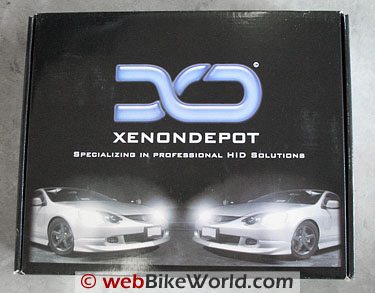

The comment by TR above aggravates me greatly. The “boo birds” are here regarding HID conversions!!!! Seriously? The majority of conversions of HID bulbs into OEM halogen reflectors produce vast amounts of glare to oncoming drivers. The possibility that all the stray light put out in every direction actually does result in better lighting is strongly offset by the danger created blinding other road users. I have zero experience with these mentioned “pivoting” bulbs but I can easily say 5he likelihood of such an arrangement actually working properly is minimal to the Nth degree! What will you end up with then? Well, in order to get best light from your high beam you’ll have to aim the headlight for that. The low beam tilt will then probably give you the wrong lighting or vice versa. AND > There’s the extreme likelihood of stray light producing blinding glare. TR’s response above tells me he is nothing more than someone with a financial interest in perpetuating installation of HID into OEM halogen reflectors. Anyone, I repeat, ANYONE, who has been out on the road for even a 1000 miles at night has encountered at least a few of these ridiculous HID headlight cuntversions which blind other road users. The only responsible way to retrofit HID is to install OEM/DOT certified HID headlight units from a donor vehicle. These feature an engineered “sharp cutoff” of the low beam to keep light where it’s needed and out of other drivers eyes. And those units will require careful aiming and leveling to achieve proper results. That’s it. There’s no other viable HID into stock halogen options. Keep in mind if you retrofit an OEM style headlight into a motorcycle, that you will end up with a headlight that works great in a straight line but poorly once leaned into a curve. You’ll likely end up with poorer performance in turns compared your OEM halogen.
By OEM certified HID retrofit mentioned above I’m referring to HID bulb and reflector combinations from say BMW Acura etc where you remove the whole unit then gut your OEM halogen headlight and install the whole HID unit. Not only will it need to be fitted securely but there will need to be aiming provisions as well to get the beam where it was designed to be and not in other drivers eyes. For clarification.